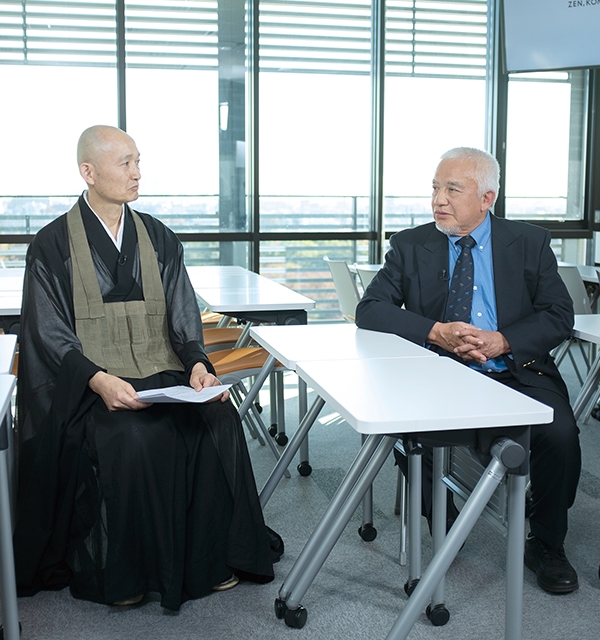
ZEN, KOMAZAWA, BREATHING
A discussion was held on the theme of “Zen Buddhism and Breathing” between leading researcher on the subject of brain substance serotonin investigation, Dr. Hideho Arita, and Prof. Tairyu Tsunoda of the Faculty of Buddhism, Komazawa University.
Dr. Arita began his neuroscientific research on Zen meditation after a flash of inspiration making him realize that “Zen meditation may be expressing the action of serotonin.” What kind of substance is serotonin, which exerts such a huge influence on people’s psychological states? Why is Zen meditation breathing beneficial in the treatment of mental disorders? Dr. Arita explained the answers to these questions as well as thinking about “happiness” and other matters from medical and scientific perspectives.
Realization of the “relationship between Zen meditation and serotonin” in Marseille
Arita:Thank you for having me today.
Tsunoda:It’s been a long time, hasn’t it, doctor?
Arita:It certainly has.
Tsunoda:It must be more than ten years ago, now. You were conducting a seminar near the temple where I am the chief priest, and as fate would have it, I attended the seminar. Since then, you have also visited my temple several times to present lectures, and so I am very much looking forward to our discussion today.
Arita:Likewise.
Tsunoda:My research specialization is Dogen Zenji (founder of the Soto school of Zen Buddhism), focusing mainly on ideological research. When we think of the teachings of Dogen Zenji, of course Zen meditation immediately comes to mind, and I also give instruction in Zen meditation at Komazawa University. Accordingly, from my perspective as someone studying Zen meditation and Dogen Zenji’s thinking, I have been interested in your research for a very long time.
Arita:Thank you.
Tsunoda:Today I would like to hear your opinions on various matters from your perspective as a researcher conducting scientific and medical research related to Zen meditation.
Arita:Happy to oblige.
Tsunoda:I think it was about 10 years ago, around the time you were at the Toho University’s Faculty of Medicine, that I myself was a subject in a study you conducted in which my brain waves during Zen meditation were measured.
Arita:Thank you for participating.
Tsunoda:We’ve gone over this before, but could you please first of all talk a little bit about your research so far and your résumé.
Arita:When I was in the university’s Faculty of Medicine, I was initially in internal medicine, and it was while I was conducting research on “sleep apnea” that I first encountered a brain substance known as “serotonin”. At that time, my research was in the field of internal medicine, and when I was investigating why sleep apnea occurred I discovered that it was because “serotonin in the brain is not being secreted properly”. Consequently, my research gained quite a lot of attention from scientists around the world, and I was invited to speak at an international conference in Marseille, France, and had the opportunity to present my research results at a gathering of serotonin specialists. In my head I had long been asking myself, “What is the action of serotonin?” but the day before I was due to make my presentation, I was walking around the port town when I had experienced something akin to a flash of inspiration. I suddenly got a kind of inspiration, or idea, that “perhaps there is somehow a relationship between Zen meditation and the action of serotonin”, and that is how I began my neuroscientific research into Zen meditation.
When I got home from the conference, I began reading various literature on Buddhism and studying serotonin research comprehensively, and I gradually became more and more convinced that there indeed may be a link between Zen meditation and the action of serotonin. I then spent around 20 years at the university verifying this theory, and I think in a sense that I have been able to prove my hypothesis.
“Dictionary of Breathing” created by more than 70 specialists
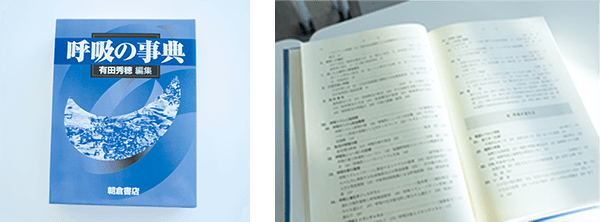
Tsunoda:Incidentally, you are known as a leading serotonin researcher, but you are also a specialist with regard to breathing. One of the reference books in my laboratory is a dictionary called the “Dictionary of Breathing”, which you edited.
I was astonished that there was such a thick dictionary on the subject of “breathing”, but I think that it can be said that you are also a leader in research on “breathing”.
Arita:This dictionary was written by around 70 researchers, and of course it includes the meditation practices of Zen monks but also breathing in relation to Noh drama and various other aspects of Japanese culture in addition to the medical aspects of breathing. Some of the slightly unusual information relates to “hiccups” and “yawning”, which are also in fact forms of breathing, and also psychological changes can cause hyperventilation. Thus in this sense breathing is an extremely broad field, and so it was necessary to have that many specialists involved in writing the dictionary.
Tsunoda:In our world, the world of Buddhist priests, breathing is of course extremely important. One Zen teacher said that, “From the moment we are born with a cry we all breathe, and so we know about breathing. However, there are very few people who truly know how which kinds of breathing to use to achieve various physical effects. Through spiritual training, thoroughly comprehend breathing.” However, from what you say I understand that breathing is related to various different fields, not just the world of Buddhist priests.
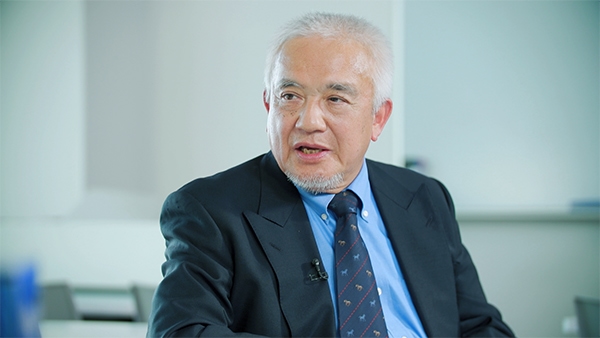
“Breathing to live” and “Breathing that affects the brain and mind”
Arita:First of all we can say that, since from the moment we are born until the moment we die, we are constantly breathing without even being aware of it, even at nighttime. This kind of breathing is undoubtedly “Breathing to live”. If we stopped breathing for even five minutes, we would die; through breathing we take in oxygen in the air and this enables the body to function, but this is an unconscious form of breathing.
The other kind of breathing is “Breathing that affects the brain and mind”. This is a different kind of breathing from that whose purpose is to take in oxygen. For example, your breathing quickens when you become anxious, or you calm down when your breathing in controlled, feeling peace of mind. In this sense, although breathing related to the mind and brain are the same “breathing” as that necessary for living, if you study them carefully they are completely different.
Breathing for living involves unconscious “breathing in” of air controlled by the diaphragm. In contrast, breathing that affects the brain and mind uses different muscles. Using the abdominal muscles, you are conscious of “breathing out”. What changes simply by performing this kind of breathing is that the cerebrum changes, the mind changes, and the body changes, and behind these changes is the action of the brain substance serotonin. This is what is gradually becoming apparent, including through our own research.
Buddha himself experienced the importance of breathing through his asceticism
Tsunoda:I believe that it was probably Buddha who first realized the importance of breathing. I’ve heard a little bit about that.
Arita:That’s right. One of the various teachings that Buddha conveyed to his disciples some 2,500 years ago is “Through Tanden breathing, not only does the mind change, but also the body.” Of course, the brain changes, too, but I think that it truly was Buddha who was the first to teach this knowledge to us humans. For this reason, when you use this breathing technique—it’s referred to as the inhaling-exhaling method”—various changes take place. Breathing exists as more than simply a means for us to take in oxygen; it is a method—an action—for adjusting and balancing our minds and bodies. This is referred to as a “breathing technique”, and neuroscientifically speaking, there is no doubt that various changes are brought about by practicing such breathing. Recently what we have been learning that these changes involve the substance serotonin.
Tsunoda:When I was a student I learned that Buddha practiced extreme asceticism for six years, and it is said that he spent much of his time during this period on studying and practicing breathing.
Arita:That’s right.
Tsunoda:I’ve heard that Buddha used his own body to conduct experiments to answer questions such as “What happens to the human body if a person holds their breath for a very long time?” or show that “Practicing this kind of breathing has this kind of effect”.
Arita:I also conducted research on Buddha, and I learned that he was an amazing physiologist. He had a frighteningly thorough knowledge if his own body, so much so that the philosopher Nietzsche referred to Buddha as a “physiologist”. The reason he became so knowledgeable is that while he was spiritual training in the mountains for six years, he thoroughly subjected himself to stress, and in a sense he gained a thorough understanding of how the mind and body change through his own experiences. And so it was against this background that he came upon this breathing technique, and this is why his insight into how this breathing technique affects the mind and body was not mistaken. Consequently, it has been passed down as truth over some 2,500 years to the present day.
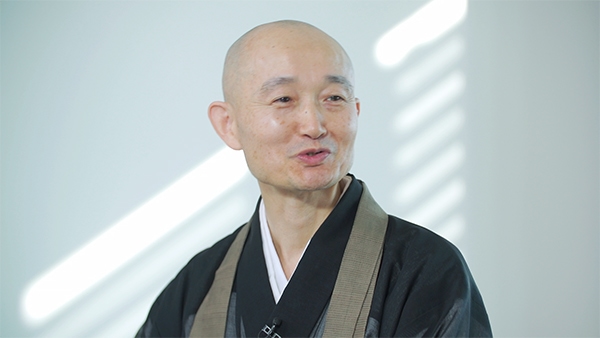
Secretion of serotonin changes facial features?
Tsunoda:In Japan today, martial arts—for example, karate, or judo, kendo fencing, and archery—all incorporate breathing techniques.
Arita:Undoubtedly this is the case. Kendo and archery are common examples, but also aikido and karate incorporate foundational breathing techniques. Even if the various movements and actions are different, the basic form of martial arts is founded on a consciousness of breathing as a “breathing technique”.
Tsunoda:Just before you were talking about serotonin, but I’m not an expert and I don’t have a good understanding, so could you please explain what serotonin basically is?
Arita:Although the study of serotonin is only around 65 years old, neuroscience is very clearly showing that serotonin is a substance that is secreted in every human brain. Serotonin nerves are located in the part of the brain called the brainstem, and these nerves secrete serotonin, spreading the substance throughout the brain. Serotonin is involved in various brain functions, but its basic function is to regulate cerebrum arousal levels and to balance the mind. Thus serotonin is related to peace of mind, and it is also related to pain regulation. Moreover, if serotonin is being secrete properly, the person’s posture and facial features will also be good.
Tsunoda:Serotonin changes people’s facial features?
Arita:That’s right. Buddhist monks all have fresh facial features and straight backs, don’t they?
Tsunoda:You mean that a person’s facial features change if they have good posture?
Arita:These two phenomena occur simultaneously. The reason for this is said to be that both the facial muscles and all the muscles holding the spinal column up straight are related to serotonin. Consequently, if serotonin is being secreted properly, the person’s facial features will firm up and their posture will improve. Of course, another action of serotonin is to balance the autonomic nerves, and so in that sense, if serotonin is being properly secreted arousal levels will be good and mental/emotional balance can be achieved, and there are also good impacts on the autonomic nervous system. In a word, our brains contain a substance with the potential to become a “source of vitality”. However, hardly any serotonin is secreted at night while you are sleeping. Since secreted only begins after the brain has been aroused, it is good to practice some form of exercise to stimulate serotonin secretion when you get up in the morning—Buddhist monks practice sutra chanting as soon as they wake up in the morning, and I think that this is an exercise that truly stimulates serotonin secretion.
Relationship between mental disorders and serotonin
Tsunoda:Is the reason we Buddhist monks practice Zen meditation strongly related to serotonin as well?
Arita:That’s right. We scientists have proven that serotonin is secreted when you practice Zen meditation, but what happens is that your mind becomes fresh and awake, and you feel positive. The autonomic nerves are also regulated. In this sense, it is serotonin that puts us in condition to live each day with vitality.
Tsunoda:I previously heard talk that serotonin is being used as a therapeutic medication for various mental disorders such as depression.
Arita:In psychiatry, what are being used to treat depression are drugs that increase serotonin in the brain. Recently we have found that in patients with depression, obsessive-compulsive disorder, and many other mental health issues, serotonin secretion is not functioning properly for various reasons—especially due to immense stress, or poor lifestyle habits—and this lack of serotonin is manifesting in the mental disorder. This serotonin deficiency can of course be cured with medicines, but recently exercises that increase serotonin such as Tanden breathing are being considered on a small scale as a means for patients to increase their own serotonin levels through their own efforts, in a sense.
Tsunoda:Is it correct to think that practicing Zen meditation increases serotonin levels, which leads to improving the patient’s condition to the point that they no longer require medication?
Arita:What is currently happening is people go to Zen temples to practice Tanden breathing, or they practice yoga or other breathing exercises. Yoga is in fact another breathing technique. Since it is possible to increase serotonin levels to a certain extent through your own efforts, even without using medication, people can proactively use these breathing techniques to revitalize their bodies and minds—this is gradually becoming apparent.
Recommending Zen meditation in a chair
Tsunoda:Since serotonin nerves are stimulated by Zen meditation, I am sure that there are many laypeople, members of the general public, who would also like to try Zen meditation, but there are several difficult aspects when it comes to formal Zen meditation (for which the person sits cross-legged on the floor). However, these days there is something called “Zen meditation in a chair”, which is being loudly recommended, even by the Zen sect.
In the case of “Zen meditation in a chair” (for which the person sits cross-legged in a chair), the person does not rest their back against the chair’s backrest but rather sit with their back straight as is the case with the formal Zen meditation style.
The person’s hands are placed with their wrists resting on their thighs, with the left hand on top of the right hand, the fingers of the two hands overlapping and the thumbs touching at their tips. Their back is stretched straight up and their chin tucked in, while their eyes remain open and looking downwards at around a 45 degree angle.
The breathing technique used is the aforementioned “Tanden breathing”. In the text Eiheikoroku, Dogen Zenji states that the air should be slowly inhaled through the nose and enter the tanden (a spot approx. 9 cm below the navel), but one Zen meditation teacher described the breathing technique as “the air entering the tanden smoothly through the nose, and then being smoothly released from the tanden to the nose.” During this exercise, the abdomen inflates and deflates.
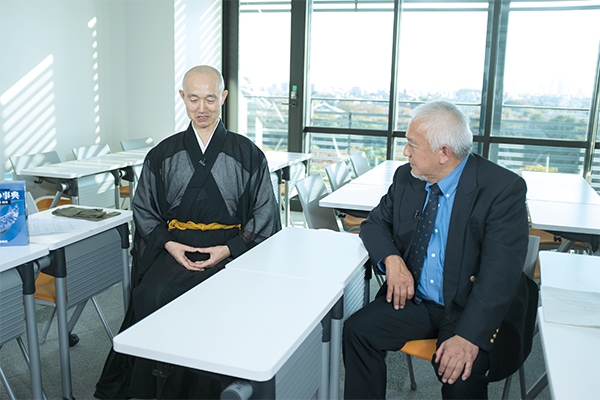
Tanden breathing mechanisms
Arita:Explaining breathing techniques from a medical perspective, firstly, the air enters the lungs, so with ordinary breathing, the abdomen does not move. Rather, it is the diaphragm (located between the lungs and stomach) that moves. This is “breathing to live”. However, Tanden breathing is a breathing technique in which the tanden, or abdomen, moves. This cannot be done unless the person does it consciously. The fact that the abdomen moves means that when the person exhales, the abdominal muscles press down tightly on the internal organs, pressing the air out. Then when the person inhales, the space pressed down by the abdominal muscles simply rises like inflating bellows.
What can change just by practicing this breathing technique? Well, a special “revitalizing substance” called serotonin is produced. Thus I believe that the moving the tanden, or abdomen, has the action of affecting the brain and changing the brain.
The meaning of practicing Zen meditation with your eyes open
Tsunoda:Just before we were talking about how Zen meditation is practiced with the eyes open, looking back at Buddhism’s traditions of the past I discovered that Zen meditation was also practices with the eyes closed. However, Dogen Zenji gave instructions to meditate with the eyes open, and so I am wondering if whether the eyes are open or closed during meditation has any relation to brain waves or serotonin.
Arita:Actually, if your mind is in a disturbed state, serotonin levels in the brain will not increase even if you practice the breathing techniques. Consequently, practicing the breathing technique in a crowded train, for example, is not very effective. However, if you practice the breathing technique at a temple or some other place where it is quiet and you can concentrate, because your brain is stimulated very little by what you see and hear, the serotonin levels in your brain will increase. This is how our brains are wired.
This is the point. However, another factor that disturbs the mind is the “worldly thoughts” that arise from within the mind itself. When you close your eyes, it is surprisingly easy for these thoughts to rise to the surface, and so in this sense, it is said that shutting your eyes can make it exceedingly difficult to concentrate.
However, since there are many Buddhists priests who are able to concentrate and continue the breathing technique with their eyes closed, I don’t think it is absolutely necessary that the eyes be kept open during meditation. I regard keeping the eyes open as one method of facilitating concentration while practicing breathing techniques.
Tsunoda:Dogen Zenji also says in his explanation of Zen meditation that a “quiet place is good”.
Moreover, Keizan Jokin (regarded as the second great founder of the Soto school of Zen) also said that “it is good to eat so that the stomach is six-parts full”, and so does that mean that eating and drinking also have an effect?
Arita:That’s right. Zen meditation is often practiced early in the morning, isn’t it? The breathing technique is probably practiced before eating much of the time, but disruptions to the mind though the five senses, trying to meditate while the inside of your body is unsettled due to eating, that’s a situation in which it would be better for you to not attempt Zen meditation. I think that what happens when you practice the breathing exercise for a certain period of time when it is possible for you to concentrate on just breathing—for example, meditating for the time it takes an incense stick to burn down—enables special substances in the brain to be produced, changing the state of the brain to one of arousal or establishing peace of mind.
Memories of experiments at Toho University
Tsunoda:It was several years ago now, but I was actually a subject in studies conducted at Toho University’s Faculty of Medicine that measured brain waves to see how they changed during Zen meditation or when Buddhism hymns or songs in praise of Buddha are sung.
Arita:If I remember correctly, at my laboratory we had you first of all perform Zen meditation, and then afterwards sing a Buddhist hymn. The data we obtained at that time was excellent. I think that the singing of Buddhist hymns is a type of breathing technique the Buddhist monks practice. The breathing techniques used in singing/chanting and the breathing techniques used in Zen meditation are in fact generating the same effects within the brain. In your case, the chanting was exceptionally clear, and changes in the brain were observed, and so my impression was that you did this quite a lot in your everyday life.
Tsunoda:Although this does not happen when I am practicing Zen meditation, I sometimes somehow feel cheered or happier when I am singing Buddhism hymns or songs in praise of Buddha. Does this have any relation to serotonin, too?
Arita:Definitely so, I would think. That is to say, not only is your brain calm and clear, but also you have happy feelings. Negative feelings are dissolved, and you start feeling somewhat positive. In your case, singing Buddhist hymns creates a situation in which it is extremely easy for this to happen. I assume that the actual amount of serotonin secreted is particularly large.
Tsunoda:The hymn I sang for the experiment was one that is chanted at Buddhist memorial services, Tsuzen Kuyo Gowasan. I remember when I was chanting that you said something like, “This is really producing a lot of alpha waves!”
Arita:That’s right, I did. The brain waves really changed unmistakably. In that sense, well in a sense, it was an astonishing result.
Tsunoda:Shall I sing the Gowasan that I sang for the experiment?
<Hymn begins>
♪♪ Tonae—Tatematsuru Tsuzen Kuyo Gowasan ni—Tama to Musubite—♪♪
<Hymn ends>
I was a bit nervous just now, and my voice was a bit high-pitched…
Arita:No, no! Just listening to you I can feel myself becoming calmer.
Tsunoda:Even within the Gowasan, the third phrase is the most rousing. It’s a song, so you could even sing it at karaoke, couldn’t you?
Arita:Of course! I think that popular songs began from song in praise of the Buddha and then gradually spread to the general public. At my laboratory I have vocalists sing songs while we investigate whether or not serotonin is being activated. There is always an unmistakable increase in serotonin levels. Results were quite good with children’s songs especially, and with other songs that are comparatively familiar. That is why, to those people who say to me, “I don’t think breathing techniques are for me,” I say, “OK, then, why don’t you try singing karaoke by yourself?” I think that karaoke is an exercise that increases serotonin levels, and in actual fact, it is quite effective in treating people with mental disorders.
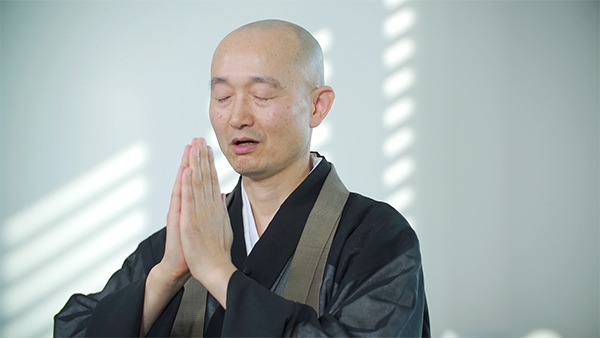
Rhythm directly connected to vital activity
Tsunoda:Previously when we were talking, you said that karaoke is good, and walking, is good, and also that you had seen baseball players overseas chewing gum in the batter’s box and that that was also good. What did you mean by that?
Arita:Fundamentally, all of these activities are “rhythmical” activities.
Tsunoda:Rhythmical?
Arita:What is more, these are rhythms that are “directly connected to vital activities”. Breathing is the action of the rhythm of breathing. Walking is the action of the rhythm of walking. Chewing gum is the action of the rhythm of chewing. By concentrating on these actions, the brain will increase serotonin levels just like with breathing techniques. Consequently, while breathing techniques are of course good, good activities other than breathing techniques that are easy to do include walking and karaoke. My research on serotonin has also obtained data indicating that chewing gum is also good.
Tsunoda:For example, in the case of Zen meditation, we usually meditate for around 40 to 50 minutes, but about how much time is necessary to achieve that state through repeating breathing rhythms?
Arita:The brain begins to change after about five minutes.
Tsunoda:Really?
Arita:That’s a minimum of five minutes. Too long is also pointless, so I would say for the average person, it would take about 20 to 30 minutes. It’s important that you don’t overdo it. Better to consider that, if you do the activity to the point that you become exhausted, it will have the opposite effect, with serotonin activity actually decreasing.
Tsunoda:When I was a subject in your study and you were taking measurements, first of all you took the subject’s blood; then you had them meditate for the Zen meditation experiment, for example; and then finally after the experiments were all complete you took their blood again. I understand that this is the measuring method you used, but in my case I recall that you took a urine sample instead of blood to use in your measurements. Why was that?
Arita:We want to measure the levels of serotonin in the brain, but since it is impossible to extract this substance from the brain of a healthy person, instead we take blood samples before and after the exercise being tested, and if certain values were higher after the exercise than before, we estimated that serotonin has been produced. Substances that are passed into the blood are ultimately passed into the urine, and so even though the results are slightly delayed, we also conduct measurements using urine two or three times to measures changes in serotonin levels within the brain.
Tsunoda:So activities such as Zen meditation and karaoke and walking—doing any of these activities causes serotonin levels in the brain to increase?
Arita:Yes, serotonin levels increase.
With serotonin, also, “persistence pays off”
Tsunoda:But once you stop doing the serotonin-increasing activity, serotonin levels will fall, won’t they?
Arita:Yes, they will. Generally speaking, serotonin levels will return to normal in between 30 minutes and an hour. Simply put, the effects of the increase in serotonin levels—for example, feeling refreshed and clear-headed or spiritually balanced, or your autonomic nerves working well—will last for around an hour at the longest.
Tsunoda:Buddhist monks’ spiritual training is repeated day after day, and so when the exercise is performed repeatedly, does serotonin also change in some way?
Arita:That is the most important point! In short, if the increased levels of serotonin only last for a mere 30 minutes to an hour, what about the remaining time? Do you have to do the exercise all over again?
In actual fact, if you practice an exercise that increases serotonin levels in the brain for, say, around 30 minutes, every day for approx. three months, the serotonin nerves will become trained. It does take a minimum of three months, but if the exercise is repeated, the brain gradually changes and becomes able to secrete serotonin in large amounts.
Thus monks carry out their everyday spiritual training in the mindset of “persistence pays off”. As this daily spiritual training continues for one then two years, serotonin secretion in their brains steadily increases. This is why Buddhist monks have such excellent posture and develop such strong peace of mind, and their minds attain such an excellent state of arousal—it is because of the increase in serotonin in their brains.
Tsunoda:So through their continuous spiritual training—such as continually practicing Zen meditation, for example— Buddhist monks are able to achieve mental stability and become people capable of maintaining a state of tranquility?
Arita:That is what I think, yes. The practice of shikantaza taught by Dogen Zenji, which is one of your specialties, where by the person simply continues the breathing technique without rest is extremely meaningful in terms of spiritual training, and its meaningfulness can also be proven neuroscientifically.
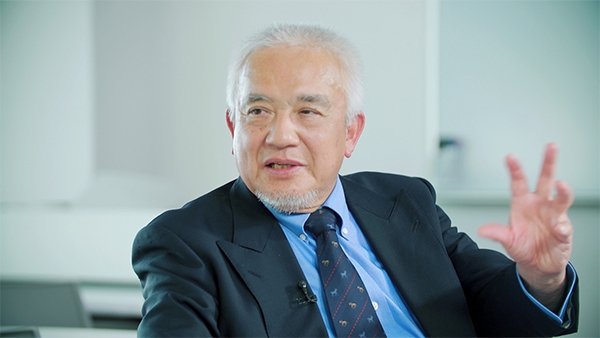
Virtuous priests cannot be tempted
Tsunoda:Certainly, people who have mastered Zen meditation by spiritual training and spiritual training seem to be extremely stable. For example, they are able to respond calmly in a range of situations.
This is slightly off-topic, but the Zen teacher who began Zen meditation here at Komazawa University, Sawaki Kodo, when he is practicing Zen meditation, he absolutely does not move until the next bell rings. For example, in summer he will not move at all even if a mosquito flies in, lands on his skin, bites him, and draws blood. If a mosquito were to land on any of us, we would want to quickly swat it away, and we would think, “Argh, this is so itchy!” so I think that being able to remain sitting perfectly still takes immense mental control.
Moreover, Theravada Buddhist monks say that there is a monk whose legs become painful from sitting cross-legged in Zen meditation, but this monk observes this pain with calm objectivity. He simply says, “Oh, my legs are getting sore.” “This is what pain feels like.” “What would happen if I just left my legs like this?” Although this is certainly one method of spiritual training to observe yourself, is this monk’s ability to feel such pain objectively something that can be cultivated?
Arita:Well, yes. It’s known as “having a mind as serene as a polished mirror [still water]”. In short, this monk’s senses are extremely stable, and he is able to ward off various stimuli or confusion entering from outside, maintaining his mind in a state that is as calm as the surface of a mirror. Actually, this phenomena can also be explained as the action of serotonin. And so the state of a Zen teacher such as the one you mentioned can be explained as a state that would be experienced by a person whose brain secretes extremely high levels of serotonin.
Tsunoda:In Buddhism we talk about “enlightenment”, and this enlightenment may ultimately take the form of realizing “Oh, this is when I achieved enlightenment”, but there is also a kind of enlightenment that comprises “a state of being able to accept various elements from the external environment and not have your mind affected by these elements.” I think that it is possible to say that this is also a state of “enlightenment”.
Arita:This is what you and other Buddhist priests actually experience, but explaining this phenomenon from a neuroscientific perspective, in fact it can be thought that the action of serotonin is what is creating a so-called state of peace of mind whereby the mind is not disturbed by every sensation or stimulant that enters from outside. This may be why Zen teachers are not tempted by various outside elements in this way.
Serotonin also controls pain
Arita:Serotonin also has another effect, which is to control pain. Monks put on all sorts of performances such as walking on hot coals, or pray under freezing cold waterfalls—they subject themselves to tremendous stress, but actually these activities are surprisingly easy for them to do. This does not mean that the priests are faking stoicism; rather, because the action of serotonin in their brains is actually very strong, their ability to control pain is also enhanced. This action of serotonin is something like that of a sedative. For this reason, people who ordinarily practice activities that activate serotonin in their brains are able to control pain without too much effort or discomfort. That is the state that serotonin creates.
Tsunoda:That means that it is possible to explain the mysterious experiences of members of the general public, or the astounding feats of people who undertake spiritual training, can also be explained neuroscientifically in this way, doesn’t it?
Arita:I doubt that this would apply to people without an accumulation of spiritual training, but for Buddhist priests—who do have an accumulation of spiritual training and have developed high levels of serotonin—performing such activities is surprisingly painless and something they can do naturally. I think that we can assume that this is the state that serotonin creates.
Tsunoda:For us Buddhist priests, even though we felt that practicing Zen meditation is extremely beneficial, until now there has been no way to prove this. Dogen Zenji also spoke about the immeasurable piousness of Zen meditation, and so I am very thankful, truly grateful, that you and other researchers have recently been investigating this phenomenon from medical and scientific perspectives.
Arita:We modern-day humans are more willing to believe something if we’re told it has a scientific explanation, rather than simply hearing words of appreciation. However, conducting this research as a scientist I also obtain data that makes me think, “Oh, so it really is true!” and so from the standpoint of persuasiveness, I think the evidence we have is sufficient. I myself will endeavor to persuade people.
The happiness of knowing satisfaction
Tsunoda:Last but not least—you have conducted research on a very wide range of topics, and I was wondering if there are any Zen terms or expressions, or any other terms or expressions, that you yourself keep in mind.
Arita:That would be “Rich is the person who is content with what he is.”
Tsunoda:Oh, I see.
Arita:In my neuroscience research, when we think about “human happiness, naturally having some kind of dream and realizing that dream links to human happiness. In actual fact, this feeling of happiness is produced not by serotonin, but by another substance in the brain—dopamine.
However, the sense of happiness of “Yay! I realized my dream!” actually lasts for a surprisingly short time, and can also be addictive. Thus people become unable to be satisfied unless they obtain things that they want one after another. This is the kind of brain that we have. In religious terms, of the so-called sins of “covetousness, anger, and foolishness”, this is the sin of covetousness”, but this state of mind is actually produced by dopamine, and in fact it is serotonin that suppresses the actions of dopamine.
This means that if you live an everyday life that facilitates serotonin activation, you will not experience this kind of covetous happiness; rather, you will be able to accept your current situation as-is and see it as being good, thereby feeling “happiness” in your everyday life. I believe that is truly what it means to live a life with serotonin, and I feel that this perhaps connects to the Zen expression I just said—“Rich is the person who is content with what he is.”
Tsunoda:That expression, “Rich is the person who is content with what he is,” means something like “Know satisfaction”.
Arita:Yes, that’s right. “Know satisfaction.”
Tsunoda:Thank you so much for the opportunity to hear your most valuable opinions today.
Arita:And thank you to you, too.
Hideho Arita
Serotonin Dojo Representative
physician (mental health, spiritual rehabilitation)
Doctor of Medicine
Professor Emeritus of the Faculty of Medicine, Toho University
A brain physiologist and physician specializing in the fields of neurology of breathing; serotonin nerve function and activation; and neuroscience of Zen. Editor of Kokyu no Jiten (“Dictionary of Breathing”) (2006; Asakura Publishing Co., Ltd.) and author of numerous books including No kara Sutoresu o Sukkiri Kesu Jiten (“Dictionary for Cleanly Erasing Stress from the Brain”) (2015; PHP Institute, Inc.)
Tairyu Tsunoda
Professor, Department of Zen Buddhist Studies, Faculty of Buddhism, Komazawa University
Chief Priest of Joen-ji Temple in Ina City, Nagano Prefecture
Research Team Leader for the Komazawa University Zen Branding Project “Soto Zen and Its Origins”. Specializes in the fields of Zen and Soto Buddhism. Author of Studies In Dogen Zenji’s Thought (2015; SHUNJU-SHA) and other works; co-author of Zen to Ringo: Sutiibu Jobuzu to iu Ikikata (“Zen and Apples: Steve Jobs’ Way of Living” (2012; Miyaobi Publishing Co., Ltd.) and other works.
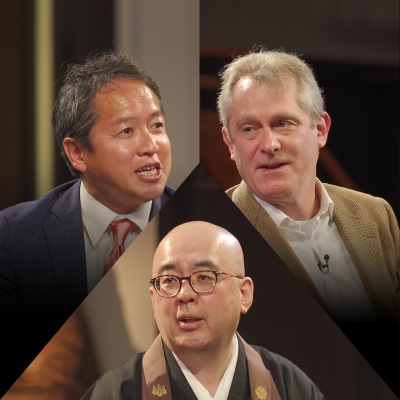
SPECIAL
ZEN,KOMAZAWA,MANAGEMENT
For our 5th discussion in this series we welcomed guest participant Mr. David Atkinson, CEO of Konishi Decorative Arts and Crafts, for a three-way dis・・・
2020.08.07
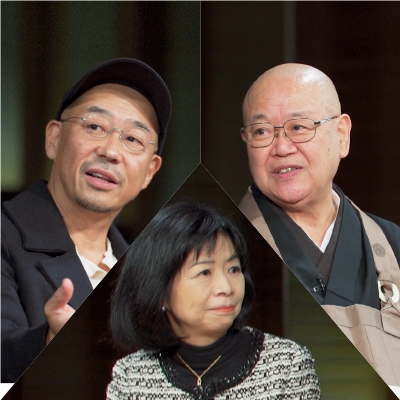
SPECIAL
ZEN,KOMAZAWA,MOVIE
For our fourth interview we welcomed film director Tatsushi Ōmori as our guest, and together with Komazawa University Chancellor Seishi Nagai and Prof・・・
2020.03.05

